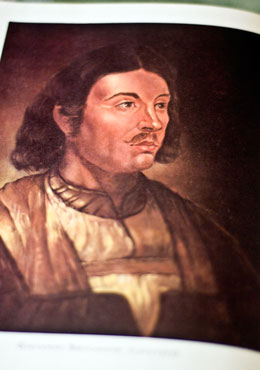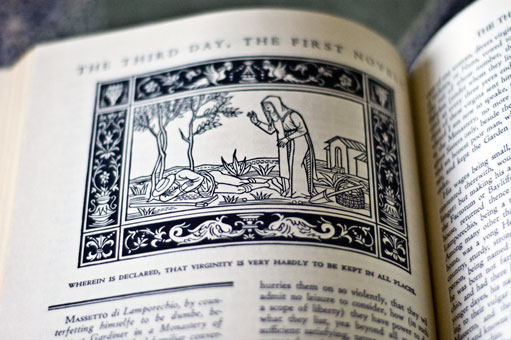About the edition:
A beautiful collector’s edition, this book features:
- Full bright red top-grade leather binding
- Genuine 22k gold gilt to all edges, front design, spine, and back
- Silk moire endsheets
- Satin bookmark, sewn-in
- Hubbed spine with raised bands
- Smyth-sewn binding for durability
- Premium acid-neutral archival paper that will not yellow
About The Decameron:
Summary
The Decameron is a collection of 100 novellas by Italian author Giovanni Boccaccio, probably begun in 1350 and finished in 1353.
It is a medieval allegorical work best known for its bawdy tales of love, appearing in all its possibilities from the erotic to the tragic. Some believe many parts of the tales are indebted to the influence of The Book of Good Love. Many notable writers, such as Geoffrey Chaucer, are said to have drawn inspiration from The Decameron.
Synopsis
The Decameron is structured in a frame narrative, or frame tale. The Decameron played a part in the history of the novel and was finished by Giovanni Boccaccio in 1353. It opens with a description of the Bubonic Plague (Black Death) and leads into an introduction of a group of seven young women and three young men who fled from plague-ridden Florence for a villa outside of the city walls. To pass the time, each member of the party tells one story for every one of the ten nights spent at the villa. The Decameron is a distinctive work, in that it describes in detail the physical, psychological and social effects that the Bubonic Plague had on that part of Europe.
One of the women, Pampinea, is elected Queen for the first day. Each day the company’s previous king/queen elects who shall succeed them and nominates the theme for the current day’s storytelling. Each day has a new theme assigned to it except for days 1 and 9: misfortunes that bring a person to a state of unexpected happiness; people who have achieved an object they greatly desired, or recovered a thing previously lost; love stories that ended unhappily; love that survived disaster; those who have avoided danger; tricks women have played on their husbands; tricks both men and women play on each other; those who have given very generously whether for love or another endeavor. Dioneo, who always speaks last, doesn’t have to conform to the day’s theme; the girls like his tales, which are full of jest, but they find that his sense of humor is sometimes immodest.
The subtitle is Prencipe Galeotto, which derives from the opening material in which Boccaccio dedicates the work to ladies of the day who did not have the diversions of men (hunting, fishing, riding, falconry) who were forced to conceal their amorous passions and stay idle and concealed in their rooms. Thus the book is subtitled Prencipe Galeotto, that is Galehaut, the go-between of Lancelot and Guinevere, a nod to Dante’s allusion to Galeotto in “Inferno V”, who was blamed for the arousal of lust in the episode of Paolo and Francesca.
Boccaccio gives introductions and conclusions to each story which describe the days activities before and after the story-telling. These inserts frequently include transcriptions of Italian folk songs and references to Italian folk dances. From the interactions among tales told within a day (or across multiple days), Boccaccio spins variations and reversals of previous material to form a cohesive whole which is more than just a collection of stories.





